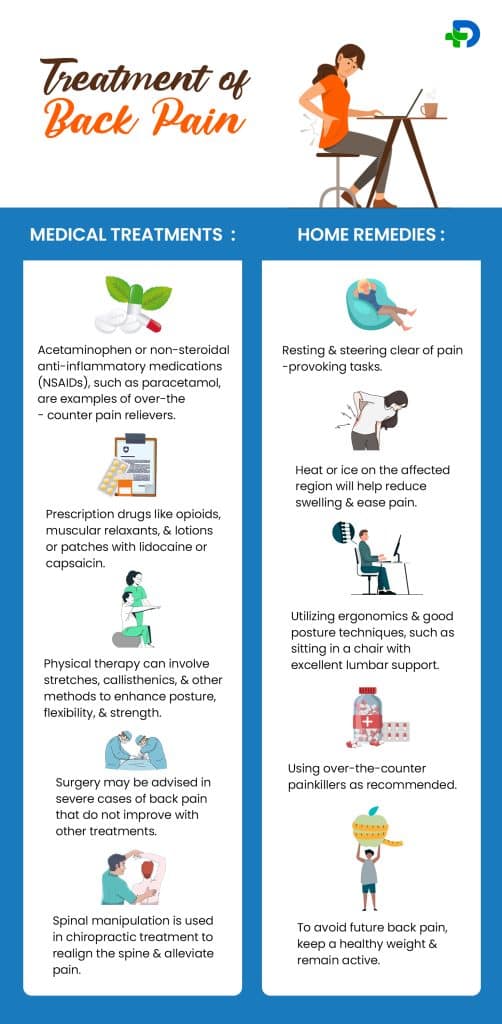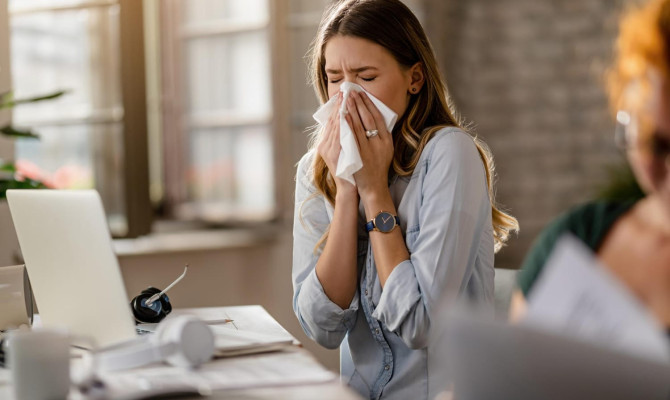Back pain : A General Overview

- Back Pain
- 14 Aug 2023
Overview
Overview
Millions of people around the world suffer from the common condition of back pain. The discomfort may be slight or severe and incapacitating, interfering with everyday activities.
Back pain can occur at any age, but it is more prevalent in people between 35 and 55.
It may be a continuous, dull ache or a sudden, sharp pain restricting movement. The back’s bones, muscles, tendons, and nerves cooperate to support and enable body movement.
Back pain can be acute or chronic. Acute back pain typically lasts less than six weeks and is brought on by an unexpected strain or injury. When back discomfort persists for more than three months, it may result from an untreated injury or underlying condition.

Causes
What are the causes of back pain?
- Muscle or ligament strain- Back pain from sudden or awkward movements, heavy lifting, or bad posture is the most typical source of back pain.
- Bulging or ruptured discs- The discs in your spine act as padding between the bones. They can press on nearby nerves when they bulge or rupture, resulting in back discomfort.
- Arthritis- Spinal joints with arthritis can become inflamed and painful. They can press on nearby nerves when they bulge or rupture, resulting in back discomfort.
- Osteoporosis- Osteoporosis is a disease that causes bones to weaken and break easily, which can cause back pain and spinal fractures.
- Skeletal irregularities- Back pain can result from some people’s skeletal abnormalities at birth or evolution.
- Spinal stenosis- The problem at hand is a narrowing of the spinal canal, which exerts pressure on the spinal cord and nerves and causes back pain, is the problem at hand.
- Kidney stones or infections- Kidney stones and infections can bring on the pain that spreads to the back.
- Fibromyalgia- This disease makes the entire body painful and tender, including the back.
- Obesity – Obesity Being overweight or obese can put more strain on your back, which can hurt.
- Bad stance- Your back muscles can strain and hurt when you slouch or lean over.
- Inactivity – Lack of exercise can result in weakened muscles and reduced flexibility, aggravating back discomfort.
- Psychological variables- Back discomfort can be aggravated by stress, anxiety, and depression.
- Cancer- Rarely, cancer that has spread to the spine may present with back discomfort. 4What are the causes of Back Pain? | Researched based study from nih.gov
Symptoms
What are the symptoms?
- The upper, middle or lower back may experience dull, sharp, intermittent, or continuous pain.
- Back stiffness or restricted range of motion.
- Muscle cramps or contractions.
- Sensitivity or discomfort in the affected region.
- Numbness, tingling or burning feeling in the back or legs.
- Weakness or exhaustion in the legs or spine.
- Difficulty walking or maintaining an upright posture.
- An ache that shoots down one or both legs, which could be sciatica.
- A lack of digestive or bladder control. 1What are the symptoms? | Researched based study from nih.gov
Diagnosis
What are the Diagnostic factors?
To identify the underlying cause of back pain, a comprehensive medical history and physical examination are essential.
- Physical examination includes testing one’s ability to stand, move, bend, and have motion and reflexes.
- X-rays, MRIs, and CT scans are examples of imaging tests that can help locate the pain’s origin.
- Blood tests like complete blood count (CBC), low levels of serum calcium and Vitamin D, Rheumatoid Factor (RF) etc. may be used to look for infections or other underlying problems.
- Occasionally, electromyography is done to evaluate nerve impulses.
Treatment

Treatment of Back pain
Medical treatments
- Acetaminophen or non-steroidal anti-inflammatory medications (NSAIDs), such as paracetamol, are examples of over-the-counter pain relievers.
- Prescription drugs like opioids, muscular relaxants, and lotions or patches with lidocaine or capsaicin. 3Treatment of Back Pain | Researched based study from nih.gov
- Physical therapy can involve stretches, callisthenics, and other methods to enhance posture, flexibility, and strength.
- Spinal manipulation is used in chiropractic treatment to realign the spine and alleviate pain.
- Acupuncture includes inserting tiny needles into particular body points to promote healing and relieve pain.
- Injections of corticosteroids or painkillers into the vertebrae to lessen swelling and discomfort.
- Surgery may be advised in severe cases of back pain that do not improve with other treatments. 2Treatment of Back Pain| Researched based study from nih.gov
Home Remedies
- Resting and steering clear of pain-provoking tasks.
- Heat or ice on the affected region will help reduce swelling and ease pain.
- Utilizing ergonomics and good posture techniques, such as sitting in a chair with excellent lumbar support.
- Following the physical therapist’s or chiropractor’s advice regarding stretches and exercises to increase flexibility and muscle.
- Using over-the-counter painkillers as recommended.
- Utilizing topical painkillers that contain lidocaine or capsaicin, such as lotions or patches.
- Utilizing relaxation methods to reduce tension, such as meditation or deep breathing.
- To avoid future back pain, keep a healthy weight and remain active.
Exercises
Exercises for back pain
Cat-cow stretch
- On your hands and knees, place one hand directly under each of your shoulders and the other under each of your hips.
- Lift your head and tailbone toward the sky as you inhale, arching your back. Put your chin in your bosom and round your spine as you exhale.
- For several breaths, alternate between the two postures by repeating this motion.
Child’s pose
- Begin on your knees and hands, placing your knees exactly beneath your hips and your hands under your shoulders.
- Reach forward with your arms while lowering your hips toward your feet and placing your forehead on the floor.
- For a while, hold this posture.
Pelvic tilt
- Your knees should be bent as you lay on your back with your feet level on the ground.
- Constrict your abdominal muscles as you exhale, tilting your pelvis toward your belly button while pressing your lower back into the earth.
- Hold for some time.
Bridge
- Your feet should be flat as you lay on your back with your legs bent.
- Squeezing your glutes and keeping your knees in line with your ankles, raise your hips toward the sky as you inhale.
- Hold for a short while before bending your spine.
Knee to chest stretch
- Your feet should be flat as you lay on your back with your legs bent.
- Use your hands to help pull one leg closer to your chest if necessary.
- Hold for a short while before letting go and changing positions.
Risk
Risk factors
- Age: Back pain is more prevalent in older people because of the wear and tear on the spine over time.
- Lack of exercise or physical action can cause the muscles in the back to weaken and hurt.
- Obesity- having a large waistline puts additional strain on the back, which can cause pain.
- Slouching or spending extended time in an uncomfortable position are examples of poor posture.
- Smoking: smoking can speed up the degeneration of the spinal discs and reduce the blood flow to the spine.
- Factors related to the workplace, such as occupations requiring heavy lifting, repetitive motions, or extended periods of sitting or standing, can cause back discomfort.
Medical conditions:
- Back pain is more likely to occur in people with certain medical conditions, such as osteoporosis or arthritis.
- Psychological factors such as worry and anxiety can cause back pain by causing muscle tension.
Prevention
Prevention of back pain
- While standing, walking, and sitting, keep a good posture.
- Regular exercise will encourage flexibility and strengthen your core.
- Lift large items safely by using your legs rather than your back.
- Don’t stay stationary for a long time while standing or seated.
- When sitting for extended times, choose a supportive and comfortable chair.
- Stretch and take pauses throughout the day.
- When exercising or playing sports, use the correct form.
- Keep your weight in check to ease the strain on your activities.
- Sleep on a cushion and mattress that are supportive.
- Reduce stress levels because they can lead to muscle tension and back discomfort. 2Prevention of Back pain | Researched based study from nih.gov
Suggestions
Living and working with back pain
- When standing or sitting, keep a good posture and use appropriate ergonomics.
- Adjust your tasks to prevent aggravating back pain.
- As a pain reliever, apply heat or cold treatment.
- Follow a doctor’s instructions when taking over-the-counter painkillers.
- Use physical therapy or moderate exercise to build muscle and increase flexibility.
- Take chiropractic or massage treatment, for example.
- Use assistive equipment, such as splints or braces, if a healthcare professional advises.
- Use relaxation methods to handle stress and ease muscle tension, such as deep breathing or meditation.
- You should see a doctor if your back discomfort persists for a long time or is coupled with other symptoms like a fever or weakness.
Takeaway
Key Takeaways
- Every year, millions of individuals are affected by the problem of back pain.
- Maintaining good posture and staying active can help prevent back pain from developing in the first place. Prevention is important.
- You should seek immediate medical care if your back pain is severe and persists for more than a few days.
- Making some lifestyle adjustments can also aid in the management of back discomfort.
- Back pain often indicates a chronic disease that needs ongoing care. This may include continuing to work with a physical therapist, taking medication as recommended, and making lasting lifestyle changes to avoid future episodes of pain.
Any feedback on this article?
 This Articles content was accurate
This Articles content was accurate Very Informative Article
Very Informative Article I have a question or a comment
I have a question or a comment
 This article contains inaccurate content
This article contains inaccurate content This article was not helpful
This article was not helpful I have a question or a comment
I have a question or a comment
We appreciate your helpful feedback!
Checkout our social pages
References
-
National Institutes of Health
Back Pain/Symptoms
-
National Institutes of Health
Back Pain: Diagnosis, Treatment, and Steps to Take/Prevention/Treatment
-
National Center for Biotechnology Information
Medical Based treatments for Back Pain
-
National Institutes of Health
Cancer related back pain/Causes



































